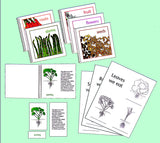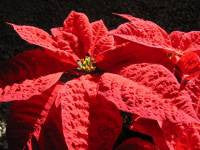The Big Picture for Botany April 28 2015, 1 Comment
I’ve heard from teachers that they are not sure what to buy or how my materials fit into their lesson sequence. Here is some information that I hope helps you with those decisions for your botany studies, as well as a link to our complete range of Montessori botany materials.
Plant Lessons: Introducing Children to Plant Form and Function. This book is the anchor for your botany studies. It gives you the lessons you need to present children with the parts of plants and what those parts do. It starts with basic lessons and continues through elementary, at least. At middle school level, it is helpful for review and to fill in gaps in plant knowledge that children may have.
botany studies. It gives you the lessons you need to present children with the parts of plants and what those parts do. It starts with basic lessons and continues through elementary, at least. At middle school level, it is helpful for review and to fill in gaps in plant knowledge that children may have.
For early childhood – Basics lessons on the parts of a plant, kinds of roots, and the parts of a stem, leaf, flower, fruit, and seed. Other lessons on the whole plant – deciduous and evergreen, plant life cycles, growth forms, and basic reproduction (whether the plant makes spores or seeds, or reproduces vegetatively). The five basic leaf shapes, and other leaf lessons as needed.
For first level elementary (6-9 year-olds) – All the lessons are appropriate, although it is highly unlikely that all be needed in the first three years of elementary. If children have not had the basic lessons listed under early childhood, they should receive those first. Past basic lessons, the lessons can be guided by the available plant materials. Lessons such as “Woody Stems in Winter” are best when the real plant material is available. Flower lessons can be matched to the flowers that are available. It is more important to use the lessons to further children’s knowledge of real plants than to march through all the nomenclature. If you follow the development of plants on your school grounds and in the area through the year, and supplement with cut flowers, you are likely to give your children an excellent foundation in botany.
 Illustrated Botany for Children is the botany nomenclature booklets and three-part cards for the children’s work in botany. The language level is simple enough that the young reader can manage it with a bit of help. There is a nomenclature booklet and accompanying cards for each of the lessons in the Plant Lessons book. The wall charts (summary charts) give a visual overview of each lesson and help children remember and review the content.
Illustrated Botany for Children is the botany nomenclature booklets and three-part cards for the children’s work in botany. The language level is simple enough that the young reader can manage it with a bit of help. There is a nomenclature booklet and accompanying cards for each of the lessons in the Plant Lessons book. The wall charts (summary charts) give a visual overview of each lesson and help children remember and review the content.
 48 Flower Cards for Study and Sorting (Botany photo card set 3) is useful both to use in flower lessons and in follow-up work for the children. The table that comes with the cards tells which cards are useful for a wide range of flower lessons. For example, children can sort cards that show tepals vs. petals and sepals, or they can use the cards to practice finding stamens or pistils.
48 Flower Cards for Study and Sorting (Botany photo card set 3) is useful both to use in flower lessons and in follow-up work for the children. The table that comes with the cards tells which cards are useful for a wide range of flower lessons. For example, children can sort cards that show tepals vs. petals and sepals, or they can use the cards to practice finding stamens or pistils.

 The Story of Poinsettias and The Amaryllis are children’s books for beginning elementary. These are available as files that you print. They are illustrated with color photos that show the botanical details. When these flowers are in season, the books are a great way to help children see the flowers’ important details. These books also work as a read-aloud for younger children.
The Story of Poinsettias and The Amaryllis are children’s books for beginning elementary. These are available as files that you print. They are illustrated with color photos that show the botanical details. When these flowers are in season, the books are a great way to help children see the flowers’ important details. These books also work as a read-aloud for younger children.
 Early Spring Flowers is another file that you print to make study and research starter cards. It helps children learn the names of flowers and see those challenging inconspicuous flowers on trees like maples and alders. Older children can learn more about the flowering plant family and other plant classification.
Early Spring Flowers is another file that you print to make study and research starter cards. It helps children learn the names of flowers and see those challenging inconspicuous flowers on trees like maples and alders. Older children can learn more about the flowering plant family and other plant classification.
 Plants We Eat is a set of six booklets and matching cards for kindergarten and beginning elementary. This material from InPrint for Children is a great way to make lessons on the parts of a plant more meaningful. The set includes a master for copying booklet for the children to color and label.
Plants We Eat is a set of six booklets and matching cards for kindergarten and beginning elementary. This material from InPrint for Children is a great way to make lessons on the parts of a plant more meaningful. The set includes a master for copying booklet for the children to color and label.
 Leaf Characteristics is another set from InPrint for Children that is very useful for kindergarten and beginning elementary. It helps children learn to observe the pertinent features for leaf description and is a good foundation for more advanced leaf studies.
Leaf Characteristics is another set from InPrint for Children that is very useful for kindergarten and beginning elementary. It helps children learn to observe the pertinent features for leaf description and is a good foundation for more advanced leaf studies.
I'll continue with recommendations for older elementary children and middle school level another day (but you can always email me with your questions). Today I feel the need to get my hands in the soil and observe my own garden plants.
Priscilla

